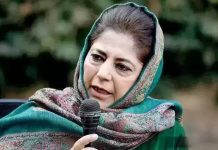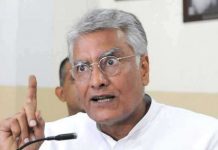 After performing the Vedic rituals of historical Bhoomi Poojan in Ayodhya, the Prime Minister Narendra Modi on this occasion said,
After performing the Vedic rituals of historical Bhoomi Poojan in Ayodhya, the Prime Minister Narendra Modi on this occasion said,
“Ram Mandir will be a modern symbol of our culture, eternal faith, national spirit and collective willpower which will inspire the generations to come.” Terming Shree Ram is the common thread of unity in diversity in the country and recalling his glorious ancient rule he announced, “The magnificence of this temple in Ayodhya will completely change the economy of the region with opening up innumerous opportunities across sectors.”
Prime Minister recalled the long struggle of Ram devotees and paid them homage for the struggle on the day their dream of Ram Mandir starting taking shape. He congratulated fellow compatriots and Ram Bhakts all across the world. Claiming it as historic, Modi said that India is starting a glorious chapter today, when people all across the country are excited and emotional to have finally achieved what they had been waiting for centuries, several of whom are may feel hard to believe that they are witnessing this day in their lifetime.
He highlighted that Ram Janmabhoomi liberated from the cycle of cycle of breaking down and building up again, and a grand temple for Ramlala would be constructed in place of tents now. Comparing Shree Ram as the of our culture, Prime Minister observed that while several attempts made to wipe out his existence, Shree Ram continues to be the foundation of our culture. He mentioned that this day stands testimony to the truth of the faith and resolution of crores of Ram Bhakts. He praised the dignity and restraint with which fellow compatriots responded, keeping the feelings of everyone in mind, when Supreme Court gave it verdict last year, and similar dignity and restraint is visible even today.
Recounting the character traits of Shree Ram, Prime Minister remarked that he always stuck to the truth, and established social harmony as the cornerstone of his rule. He loved his subjects equally, but had a special kindness for the poor and the needy. There is no aspect of life where Shree Ram doesn’t serve as an inspiration, and his impact is visible in several aspects of culture, philosophy, faith and tradition of the country.
Prime Minister Modi emphasized that the temple should be constructed on the foundation of mutual love and brotherhood. He said that through ‘sabka saath’ and with ‘sabka vishwas’, we need to achieve ‘sabka vikaas’ and make a self-confident and Aatmanirbhar Bharat. He underlined that the message of Shree Ram, that there should not be any delay and we should move forward, is the message which the country needs to follow.
PM Modi ended by recalling the significance of the path of ‘Maryada’ of Shree Ram in the backdrop of the COVID situation. He said that the current situation demands the maryada to be ‘Do gaz ki doori – Mask hai Zaroori’ ( Two Yard distance and wearing Mask is essential) and exhorted everyone to follow the same.
Earlier after landing at Ayodhya he was accorded warm welcome by Governor Anandi Ben Patel, Chief Minister Yogi Adityanth and his team of ministers and officials. From helipad he drove straight to Hanumangarhi temple where he performed Pooja and Aarti. Then he went to makeshift temple of Ram Lalla (Childhood Rama) and paid respect bowing before his idols.
At a ceremony organised after the Bhoomi Pujan among the specially invited limited saint chiefs had limited dignitaries RSS chief Dr Mohan Bhagwat, Governor Anandi Ben Patel, Chief Minister Yogi Adityanath, Ram Janam Bhoomi Chhetra Trust Chief Mahan Nritya Gopal Das and its Secretary Champat Rai shared the dais with Prime Minister Narendra Modi.
RSS Chief Dr Mohan Bhagwat remembered the then RSS chief Balasaheb Deoras telling how he prepared them to struggle for 20 to 30 years for the cause of Ram temple to achieve victory. We struggled and at the beginning of the 30th year, we have attained the joy of fulfilling our resolution. Welcoming the Prime Minister UP Chief Minister Yogi Aditynath highlighted various development schemes that facelift the banks of Saryu rivers and beatification of traditional Ghats, Roads and transport facilities.













